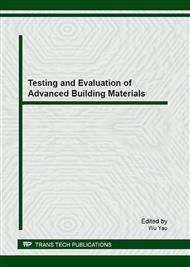p.205
p.211
p.215
p.220
p.225
p.230
p.235
p.239
p.244
Phosphate Bonding: A New Method for Using Large Volume of Fly Ash
Abstract:
Magnesium phosphate cements (MPC) with larger volume of fly ash were studied in the present work. Dead burned magnesia, phosphates and fly ash were the components of MPC. The volume of fly ash in MPC was 70%, 75% and 80%, respectively. Three phosphates, monosodium phosphate (MSP), monopotassium phosphate (MPP) and monoammonium phosphate (MAP) were used. Compressive strength of the three MPC mortars with different fly ash content was determined. Results show that the compressive strength reduced with the proportion increase of fly ash, increased with the curing time. After cured 28 days in the lab air, the compressive strength of cement mortar can reach 14MPa, when the fly ash dosage was 80% by weight of cement. The reaction product is struvite of potassium (KMgPO4•6H2O) in potassium phosphate based MPC, and hydrated sodium phosphate (Na2HPO4•17H2O) in sodium phosphate based MPC. The results indicate that MPC has capacity to bond large volume of fly ash. A new way to utilize fly ash in a large scale can be realized by phosphate bonding.
Info:
Periodical:
Pages:
225-229
Citation:
Online since:
January 2013
Authors:
Keywords:
Price:
Сopyright:
© 2013 Trans Tech Publications Ltd. All Rights Reserved
Share:
Citation:


